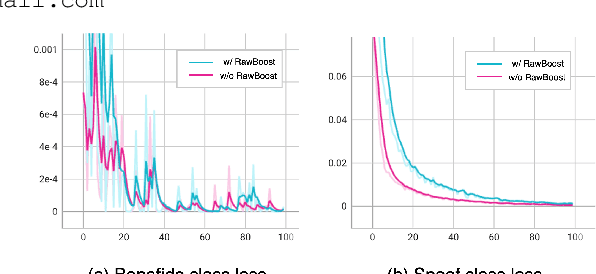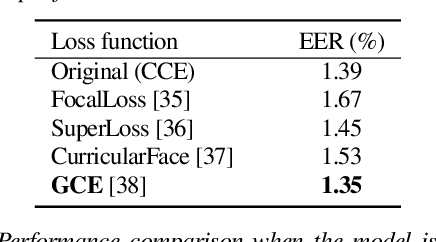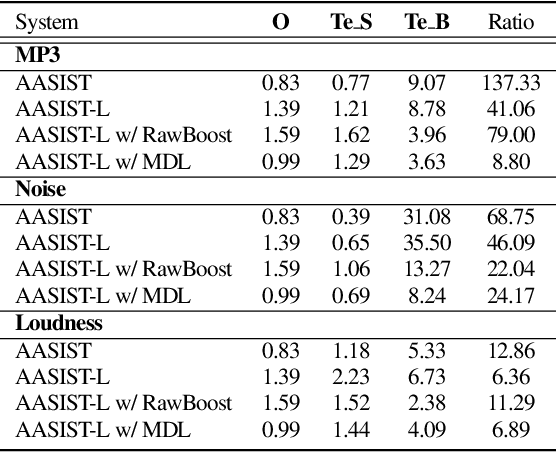Md Sahidullah
MULTISPEECH
ASVspoof 5: Design, Collection and Validation of Resources for Spoofing, Deepfake, and Adversarial Attack Detection Using Crowdsourced Speech
Feb 13, 2025Abstract:ASVspoof 5 is the fifth edition in a series of challenges which promote the study of speech spoofing and deepfake attacks as well as the design of detection solutions. We introduce the ASVspoof 5 database which is generated in crowdsourced fashion from data collected in diverse acoustic conditions (cf. studio-quality data for earlier ASVspoof databases) and from ~2,000 speakers (cf. ~100 earlier). The database contains attacks generated with 32 different algorithms, also crowdsourced, and optimised to varying degrees using new surrogate detection models. Among them are attacks generated with a mix of legacy and contemporary text-to-speech synthesis and voice conversion models, in addition to adversarial attacks which are incorporated for the first time. ASVspoof 5 protocols comprise seven speaker-disjoint partitions. They include two distinct partitions for the training of different sets of attack models, two more for the development and evaluation of surrogate detection models, and then three additional partitions which comprise the ASVspoof 5 training, development and evaluation sets. An auxiliary set of data collected from an additional 30k speakers can also be used to train speaker encoders for the implementation of attack algorithms. Also described herein is an experimental validation of the new ASVspoof 5 database using a set of automatic speaker verification and spoof/deepfake baseline detectors. With the exception of protocols and tools for the generation of spoofed/deepfake speech, the resources described in this paper, already used by participants of the ASVspoof 5 challenge in 2024, are now all freely available to the community.
IITKGP-ABSP Submission to LRE22: Language Recognition in Low-Resource Settings
Jan 15, 2025Abstract:This is the detailed system description of the IITKGP-ABSP lab's submission to the NIST language recognition evaluation (LRE) 2022. The objective of this LRE (LRE22) is focused on recognizing 14 low-resourced African languages. Even though NIST has provided additional training and development data, we develop our systems with additional constraints of extreme low-resource. Our primary fixed-set submission ensures the usage of only the LRE 22 development data that contains the utterances of 14 target languages. We further restrict our system from using any pre-trained models for feature extraction or classifier fine-tuning. To address the issue of low-resource, our system relies on diverse audio augmentations followed by classifier fusions. Abiding by all the constraints, the proposed methods achieve an EER of 11.43% and cost metric of 0.41 in the LRE22 development set. For users with limited computational resources or limited storage/network capabilities, the proposed system will help achieve efficient LID performance.
Explaining Speaker and Spoof Embeddings via Probing
Dec 24, 2024



Abstract:This study investigates the explainability of embedding representations, specifically those used in modern audio spoofing detection systems based on deep neural networks, known as spoof embeddings. Building on established work in speaker embedding explainability, we examine how well these spoof embeddings capture speaker-related information. We train simple neural classifiers using either speaker or spoof embeddings as input, with speaker-related attributes as target labels. These attributes are categorized into two groups: metadata-based traits (e.g., gender, age) and acoustic traits (e.g., fundamental frequency, speaking rate). Our experiments on the ASVspoof 2019 LA evaluation set demonstrate that spoof embeddings preserve several key traits, including gender, speaking rate, F0, and duration. Further analysis of gender and speaking rate indicates that the spoofing detector partially preserves these traits, potentially to ensure the decision process remains robust against them.
ASVspoof 5: Crowdsourced Speech Data, Deepfakes, and Adversarial Attacks at Scale
Aug 16, 2024



Abstract:ASVspoof 5 is the fifth edition in a series of challenges that promote the study of speech spoofing and deepfake attacks, and the design of detection solutions. Compared to previous challenges, the ASVspoof 5 database is built from crowdsourced data collected from a vastly greater number of speakers in diverse acoustic conditions. Attacks, also crowdsourced, are generated and tested using surrogate detection models, while adversarial attacks are incorporated for the first time. New metrics support the evaluation of spoofing-robust automatic speaker verification (SASV) as well as stand-alone detection solutions, i.e., countermeasures without ASV. We describe the two challenge tracks, the new database, the evaluation metrics, baselines, and the evaluation platform, and present a summary of the results. Attacks significantly compromise the baseline systems, while submissions bring substantial improvements.
Beyond Silence: Bias Analysis through Loss and Asymmetric Approach in Audio Anti-Spoofing
Jun 25, 2024



Abstract:Current trends in audio anti-spoofing detection research strive to improve models' ability to generalize across unseen attacks by learning to identify a variety of spoofing artifacts. This emphasis has primarily focused on the spoof class. Recently, several studies have noted that the distribution of silence differs between the two classes, which can serve as a shortcut. In this paper, we extend class-wise interpretations beyond silence. We employ loss analysis and asymmetric methodologies to move away from traditional attack-focused and result-oriented evaluations towards a deeper examination of model behaviors. Our investigations highlight the significant differences in training dynamics between the two classes, emphasizing the need for future research to focus on robust modeling of the bonafide class.
Exploring Green AI for Audio Deepfake Detection
Mar 21, 2024



Abstract:The state-of-the-art audio deepfake detectors leveraging deep neural networks exhibit impressive recognition performance. Nonetheless, this advantage is accompanied by a significant carbon footprint. This is mainly due to the use of high-performance computing with accelerators and high training time. Studies show that average deep NLP model produces around 626k lbs of CO\textsubscript{2} which is equivalent to five times of average US car emission at its lifetime. This is certainly a massive threat to the environment. To tackle this challenge, this study presents a novel framework for audio deepfake detection that can be seamlessly trained using standard CPU resources. Our proposed framework utilizes off-the-shelve self-supervised learning (SSL) based models which are pre-trained and available in public repositories. In contrast to existing methods that fine-tune SSL models and employ additional deep neural networks for downstream tasks, we exploit classical machine learning algorithms such as logistic regression and shallow neural networks using the SSL embeddings extracted using the pre-trained model. Our approach shows competitive results compared to the commonly used high-carbon footprint approaches. In experiments with the ASVspoof 2019 LA dataset, we achieve a 0.90\% equal error rate (EER) with less than 1k trainable model parameters. To encourage further research in this direction and support reproducible results, the Python code will be made publicly accessible following acceptance. Github: https://github.com/sahasubhajit/Speech-Spoofing-
Assessing the Robustness of Spectral Clustering for Deep Speaker Diarization
Mar 21, 2024Abstract:Clustering speaker embeddings is crucial in speaker diarization but hasn't received as much focus as other components. Moreover, the robustness of speaker diarization across various datasets hasn't been explored when the development and evaluation data are from different domains. To bridge this gap, this study thoroughly examines spectral clustering for both same-domain and cross-domain speaker diarization. Our extensive experiments on two widely used corpora, AMI and DIHARD, reveal the performance trend of speaker diarization in the presence of domain mismatch. We observe that the performance difference between two different domain conditions can be attributed to the role of spectral clustering. In particular, keeping other modules unchanged, we show that differences in optimal tuning parameters as well as speaker count estimation originates due to the mismatch. This study opens several future directions for speaker diarization research.
ChildAugment: Data Augmentation Methods for Zero-Resource Children's Speaker Verification
Feb 23, 2024



Abstract:The accuracy of modern automatic speaker verification (ASV) systems, when trained exclusively on adult data, drops substantially when applied to children's speech. The scarcity of children's speech corpora hinders fine-tuning ASV systems for children's speech. Hence, there is a timely need to explore more effective ways of reusing adults' speech data. One promising approach is to align vocal-tract parameters between adults and children through children-specific data augmentation, referred here to as ChildAugment. Specifically, we modify the formant frequencies and formant bandwidths of adult speech to emulate children's speech. The modified spectra are used to train ECAPA-TDNN (emphasized channel attention, propagation, and aggregation in time-delay neural network) recognizer for children. We compare ChildAugment against various state-of-the-art data augmentation techniques for children's ASV. We also extensively compare different scoring methods, including cosine scoring, PLDA (probabilistic linear discriminant analysis), and NPLDA (neural PLDA). We also propose a low-complexity weighted cosine score for extremely low-resource children ASV. Our findings on the CSLU kids corpus indicate that ChildAugment holds promise as a simple, acoustics-motivated approach, for improving state-of-the-art deep learning based ASV for children. We achieve up to 12.45% (boys) and 11.96% (girls) relative improvement over the baseline.
Generalizing Speaker Verification for Spoof Awareness in the Embedding Space
Jan 28, 2024



Abstract:It is now well-known that automatic speaker verification (ASV) systems can be spoofed using various types of adversaries. The usual approach to counteract ASV systems against such attacks is to develop a separate spoofing countermeasure (CM) module to classify speech input either as a bonafide, or a spoofed utterance. Nevertheless, such a design requires additional computation and utilization efforts at the authentication stage. An alternative strategy involves a single monolithic ASV system designed to handle both zero-effort imposter (non-targets) and spoofing attacks. Such spoof-aware ASV systems have the potential to provide stronger protections and more economic computations. To this end, we propose to generalize the standalone ASV (G-SASV) against spoofing attacks, where we leverage limited training data from CM to enhance a simple backend in the embedding space, without the involvement of a separate CM module during the test (authentication) phase. We propose a novel yet simple backend classifier based on deep neural networks and conduct the study via domain adaptation and multi-task integration of spoof embeddings at the training stage. Experiments are conducted on the ASVspoof 2019 logical access dataset, where we improve the performance of statistical ASV backends on the joint (bonafide and spoofed) and spoofed conditions by a maximum of 36.2% and 49.8% in terms of equal error rates, respectively.
Speaker Verification Across Ages: Investigating Deep Speaker Embedding Sensitivity to Age Mismatch in Enrollment and Test Speech
Jun 13, 2023Abstract:In this paper, we study the impact of the ageing on modern deep speaker embedding based automatic speaker verification (ASV) systems. We have selected two different datasets to examine ageing on the state-of-the-art ECAPA-TDNN system. The first dataset, used for addressing short-term ageing (up to 10 years time difference between enrollment and test) under uncontrolled conditions, is VoxCeleb. The second dataset, used for addressing long-term ageing effect (up to 40 years difference) of Finnish speakers under a more controlled setup, is Longitudinal Corpus of Finnish Spoken in Helsinki (LCFSH). Our study provides new insights into the impact of speaker ageing on modern ASV systems. Specifically, we establish a quantitative measure between ageing and ASV scores. Further, our research indicates that ageing affects female English speakers to a greater degree than male English speakers, while in the case of Finnish, it has a greater impact on male speakers than female speakers.
 Add to Chrome
Add to Chrome Add to Firefox
Add to Firefox Add to Edge
Add to Edge